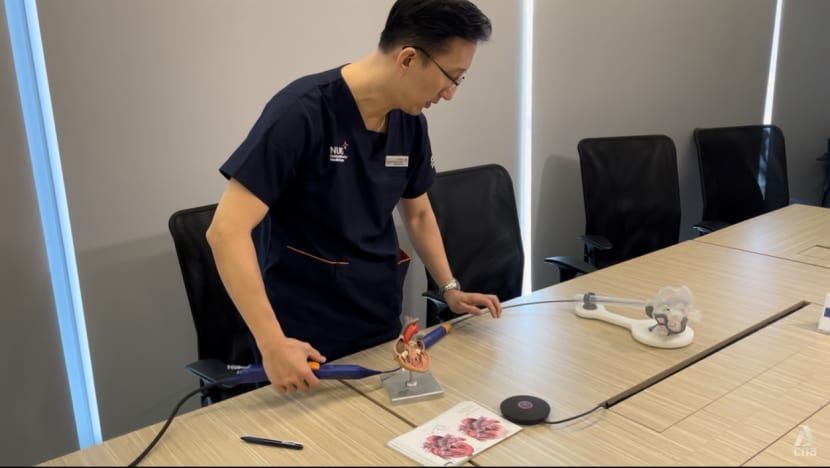Some patients with heart rhythm disorders can undergo newer, safer procedure

Associate Professor Seow Swee Chong demonstrating how the new technique works during a press conference. (Photo: CNA/Sabrina Ng)
SINGAPORE: Mr Zhang Feng has led a healthy lifestyle since young, even taking part in sports competitively.
But in the past five years, the 46-year-old experienced bouts of breathlessness, even when doing typically easy activities such as climbing up the stairs.
After consulting a doctor, he underwent an electrocardiogram (ECG) examination. It confirmed he had a type of heart rhythm disorder called atrial fibrillation.
If left untreated, the condition could lead to serious complications such as heart failure.
He opted for a new minimally invasive procedure offered at the National University Heart Centre, Singapore (NUHCS) to treat the problem in January this year.
USING THERMAL ENERGY FOR ABLATION
One procedure to treat atrial fibrillation, is ablation, which involves inserting tubes into the heart through the groin.
Scars are created in the heart to act as a “barrier” to block abnormal signals.
Ablation is currently done using thermal energy, but it comes with downsides – surrounding healthy veins are often damaged during the treatment.
“Traditional sources of energy, either heat or cold, tend to cause collateral damage to other tissues apart from the heart muscle that we're targeting,” said Dr Seow Swee-Chong, director of Cardiac Electrophysiology and Pacing at NUHCS.
Depending on which structure is damaged, the consequences can be “dire”, said Dr Seow, who is also senior consultant at the Department of Cardiology.
For instance, if there is damage to the food tube that runs behind the heart, that can result in atrial-esophageal fistula which can lead to stroke, infection or bleeding, he said.
NEWER ABLATION TECHNIQUE
In contrast, the newer technique, called pulsed field ablation, uses electrical pulses which makes the procedure more precise as it is very “tissue-selective”, he said.
“It manages to deliver the ablation lesions within the heart muscle without causing damage to nerves, blood vessels, and the esophagus,” he said.
The new technique is already being used in Europe and Australia. The hospital said trials with the new method of doing ablation using pulsed field have shown that damage to surrounding veins has dropped from 3 per cent to none at all.

The new procedure also takes one-and-a-half to two hours, about half the amount of time it used to take.
Mr Zhang had initially tried to use medication to help control his heartbeat but felt that he wanted to resolve the root cause. He then decided to go for the new procedure based on its benefits.
“I didn't want to take long-term medication as I think I'm still young ... I don't want to cause any long-term side effects to my other organs like liver and kidney,” he said.
“I felt the difference immediately and the wound healed very well,” he told CNA938’s Asia First on Tuesday (Jun 20).
NUMBERS EXPECTED TO RISE
NUHCS sees up to 6,000 patients with the same problem as Mr Zhang – atrial fibrillation – each year.
Dr Seow said that this number is set to rise with an ageing population in Singapore. Nearly 2 per cent of people here currently have the condition.
"The higher incidence of AF (atrial fibrillation) is also due to the rise in lifestyle diseases like hypertension, diabetes, obesity,” he said.
The hospital is sourcing more machines as it expects more patients to opt for this new approach.
While there is no age limit for the procedure, Dr Seow said ablation is typically offered to patients younger than 75 years old.



















